IoT-Based Airport Noise Perception and Monitoring: Multi-Source Data Fusion, Spatial Distribution Modeling, and Analysis
Abstract
1. Introduction
2. Materials and Methods
2.1. Sensor-Related Technology
2.2. Multi-Source Data Fusion
2.3. Spatial Distribution Modeling
2.3.1. Inverse Distance Weighting (IDW)
2.3.2. Kriging Interpolation
2.4. Noise Theoretical Methods
3. System Architecture
3.1. Noise Monitoring Framework
3.1.1. Perception Layer
3.1.2. Transmission Layer
3.1.3. Processing Layer
3.1.4. Application Layer
3.2. Data Acquisition and Network Transmission
4. Results
4.1. Site Layout
4.2. Data Acquisition and Analysis
4.3. Noise Event Correlation
4.4. Spatial Distribution Model
4.4.1. Pre-Monitoring Data
4.4.2. Spatial Interpolation
- Inverse Distance Weighting (IDW)
- Kriging Interpolation
- Results Analysis
5. Discussion on Error Assessment and Model Optimization
5.1. Error Origins
- Measurement Error from Sensors
- Error in Data Fusion
- Error in Spatial Interpolation
5.2. Methodology for Error Assessment
- Cross-Validation
- Comparison with Empirical Data
- Sensitivity Analysis
5.3. Strategies for Model Optimization
- Optimization of Sensor Calibration and Layout
- Data Preprocessing and Quality Control
- Hybrid Interpolation Model
- Integration of Machine Learning
- Three-dimensional noise modeling
6. Conclusions
Author Contributions
Funding
Institutional Review Board Statement
Informed Consent Statement
Data Availability Statement
Conflicts of Interest
References
- Wright, D.M.; Newell, K.; Maguire, A.; O’Reilly, D. Aircraft noise and self-assessed mental health around a regional urban airport: A population based record linkage study. Environ. Health 2018, 17, 74. [Google Scholar] [CrossRef] [PubMed]
- Bozkurt, T.S. Preparation of Industrial Noise Mapping and Improvement of Environmental Quality. Curr. Pollut. Rep. 2021, 7, 325–343. [Google Scholar] [CrossRef] [PubMed]
- Setyowati, E.; Budihardjo, M.A.; Putri, A.R. Establishing Grounds for Building Orientation Mapping and Validation of Noise Level Correlation Modeling on Aircraft Take-off and Landing. Buildings 2019, 9, 27. [Google Scholar] [CrossRef]
- Jarosińska, D.; Héroux, M.-È.; Wilkhu, P.; Creswick, J.; Verbeek, J.; Wothge, J.; Paunović, E. Development of the WHO Environmental Noise Guidelines for the European Region: An Introduction. Int. J. Environ. Res. Public Health 2018, 15, 813. [Google Scholar] [CrossRef]
- Basner, M.; McGuire, S. WHO Environmental Noise Guidelines for the European Region: A Systematic Review on Environmental Noise and Effects on Sleep. Int. J. Environ. Res. Public Health 2018, 15, 519. [Google Scholar] [CrossRef]
- Scatolini, F.; Alves, C.J.P. Background noise analysis in urban airport surroundings of Brazilian cities, Congonhas Airport, São Paulo. Rev. Saude Publica 2016, 50, 69. [Google Scholar] [CrossRef]
- Verhulst, S.; Harte, J.M.; Dau, T. Temporal suppression and augmentation of click-evoked otoacoustic emissions. Hear. Res. 2008, 246, 23–35. [Google Scholar] [CrossRef][Green Version]
- Georganti, E.; Mourjopoulos, J.; Jacobsen, F. Analysis of room transfer function and reverberant signal statistics. J. Acoust. Soc. Am. 2008, 123, 3761. [Google Scholar] [CrossRef]
- Konovalova, O. ANALYSIS OF CRITERIA AND STRATEGIES USED FOR NOISE MONITORING AT AIRPORTS. Proc. Natl. Aviat. Univ. 2015, 63, 99–105. [Google Scholar] [CrossRef]
- Zelenko, Y.; Zelenko, D.; Neduzha, L. Contemporary principles for solving the problem in noise reduction from railway rolling stock. IOP Conf. Ser. Mater. Sci. Eng. 2020, 985, 012015. [Google Scholar] [CrossRef]
- Govea, J.; Gaibor-Naranjo, W.; Sanchez-Viteri, S.; Villegas-Ch, W. Integration of Data and Predictive Models for the Evaluation of Air Quality and Noise in Urban Environments. Sensors 2024, 24, 311. [Google Scholar] [CrossRef] [PubMed]
- Rodríguez-Pérez, N.; Caballero-Gil, P.; Toledo-Castro, J.; Santos-González, I.; Hernández-Goya, C. Monitoring Environmental Conditions in Airports with Wireless Sensor Networks. Proceedings 2018, 2, 1260. [Google Scholar] [CrossRef]
- Luo, L.; Qin, H.; Song, X.; Wang, M.; Qiu, H.; Zhou, Z. Wireless Sensor Networks for Noise Measurement and Acoustic Event Recognitions in Urban Environments. Sensors 2020, 20, 2093. [Google Scholar] [CrossRef] [PubMed]
- Ahmad, R.; Alkhammash, E.H. Online Adaptive Kalman Filtering for Real-Time Anomaly Detection in Wireless Sensor Networks. Sensors 2024, 24, 5046. [Google Scholar] [CrossRef]
- Peckens, C.; Porter, C.; Rink, T. Wireless Sensor Networks for Long-Term Monitoring of Urban Noise. Sensors 2018, 18, 3161. [Google Scholar] [CrossRef]
- Kwasiborska, A.; Skorupski, J. Operational restrictions for reducing noise and the safety of air operations. Sci. J. Silesian Univ. Technol. Ser. Transp. 2017, 94, 89–98. [Google Scholar] [CrossRef]
- ISO 20906:2009; Acoustics—Acoustic Unattended Monitoring of Aircraft Sound in the Vicinity of Airports. ISO—International Organization for Standardization: Geneva, Switzerland, 2009.
- Xie, J.; Zhu, L.; Lee, H.M. Novel Methodologies for the Development of Large-Scale Airport Noise Map. Sustainability 2022, 14, 6573. [Google Scholar] [CrossRef]
- Zuo, J.; Xia, H.; Liu, S.; Qiao, Y. Mapping Urban Environmental Noise Using Smartphones. Sensors 2016, 16, 1692. [Google Scholar] [CrossRef]
- Wickramathilaka, N.; Ujang, U.; Azri, S.; Choon, T.L. Calculation of Road Traffic Noise, Development of Data, and Spatial Interpolations for Traffic Noise Visualization in Three-dimensional Space. Geomat. Environ. Eng. 2023, 17, 61–85. [Google Scholar] [CrossRef]
- Nasr, A.A.; Puharić, M.; Ilić, I.; Stanković, I.; Sukić, E. Assessment and Predictions of Air Traffic Noise at Mitiga International Airport in Tripoli, Libya. Pol. J. Environ. Stud. 2024, 33, 1309–1324. [Google Scholar] [CrossRef]
- Falivene, O.; Cabrera, L.; Tolosana-Delgado, R.; Sáez, A. Interpolation algorithm ranking using cross-validation and the role of smoothing effect. A coal zone example. Comput. Geosci. 2010, 36, 512–519. [Google Scholar] [CrossRef]
- Harman, B.I.; Koseoglu, H.; Yigit, C.O. Performance evaluation of IDW, Kriging and multiquadric interpolation methods in producing noise mapping: A case study at the city of Isparta, Turkey. Appl. Acoust. 2016, 112, 147–157. [Google Scholar] [CrossRef]
- Che, D.; Jia, Q. Three-dimensional geological modeling of coal seams using weighted Kriging method and multi-Source data. IEEE Access 2019, 7, 118037–118045. [Google Scholar] [CrossRef]
- Comber, A.; Zeng, W. Spatial interpolation using areal features: A review of methods and opportunities using new forms of data with coded illustrations. Geogr. Compass 2019, 13, e12465. [Google Scholar] [CrossRef]
- Benocci, R.; Roman, H.E.; Zambon, G. Optimized Sensors Network and Dynamical Maps for Monitoring Traffic Noise in a Large Urban Zone. Appl. Sci. 2021, 11, 8363. [Google Scholar] [CrossRef]
- Oh, G.; Sim, J.-H.; Won, M.; Jung, M.; Mantry, S.P.; Kim, D.-S. Integrated Temperature–Humidity Sensors for a Pouch-Type Battery Using 100% Printing Process. Sensors 2024, 24, 104. [Google Scholar] [CrossRef]
- Udrea, I.; Gheorghe, V.I.; Dogeanu, A.M. Optimizing Greenhouse Design with Miniature Models and IoT (Internet of Things) Technology—A Real-Time Monitoring Approach. Sensors 2024, 24, 2261. [Google Scholar] [CrossRef]
- Demirezen, M.U.; Navruz, T.S. Performance Analysis of Lambda Architecture-Based Big-Data Systems on Air/Ground Surveillance Application with ADS-B Data. Sensors 2023, 23, 7580. [Google Scholar] [CrossRef]
- Peyrin, F.; Fréville, P.; Montoux, N.; Baray, J.-L. Original and Low-Cost ADS-B System to Fulfill Air Traffic Safety Obligations during High Power LIDAR Operation. Sensors 2023, 23, 2899. [Google Scholar] [CrossRef]
- Le, N.T.; Thwe Chit, M.M.; Truong, T.L.; Siritantikorn, A.; Kongruttanachok, N.; Asdornwised, W.; Chaitusaney, S.; Benjapolakul, W. Deployment of Smart Specimen Transport System Using RFID and NB-IoT Technologies for Hospital Laboratory. Sensors 2023, 23, 546. [Google Scholar] [CrossRef]
- Segura Garcia, J.; Pérez Solano, J.J.; Cobos Serrano, M.; Navarro Camba, E.A.; Felici Castell, S.; Soriano Asensi, A.; Montes Suay, F. Spatial Statistical Analysis of Urban Noise Data from a WASN Gathered by an IoT System: Application to a Small City. Appl. Sci. 2016, 6, 380. [Google Scholar] [CrossRef]
- ArcGIS Platform. Available online: http://www.esri.com/software/arcgis (accessed on 15 January 2025).
- Benslama, A.; Khanchoul, K.; Benbrahim, F.; Boubehziz, S.; Chikhi, F.; Navarro-Pedreño, J. Monitoring the Variations of Soil Salinity in a Palm Grove in Southern Algeria. Sustainability 2020, 12, 6117. [Google Scholar] [CrossRef]
- Chen, X.; Zhang, H.; Wong, C.U.I.; Li, F. Investigation of the Spatio-Temporal Distribution and Seasonal Origin of Atmospheric PM2.5 in Chenzhou City. Appl. Sci. 2024, 14, 11221. [Google Scholar] [CrossRef]
- Technical Specifications for Monitoring of Aircraft Noise in the Vicinity of Airports. Available online: https://www.mee.gov.cn/xxgk2018/xxgk/xxgk06/202404/t20240419_1071150.html (accessed on 26 January 2025). (In Chinese)
- Zaporozhets, O.; Levchenko, L. Accuracy of Noise-Power-Distance Definition on Results of Single Aircraft Noise Event Calculation. Aerospace 2021, 8, 121. [Google Scholar] [CrossRef]
- Wu, C.; Redonnet, S. Prediction of Aircraft Noise Impact with Application to Hong Kong International Airport. Aerospace 2021, 8, 264. [Google Scholar] [CrossRef]
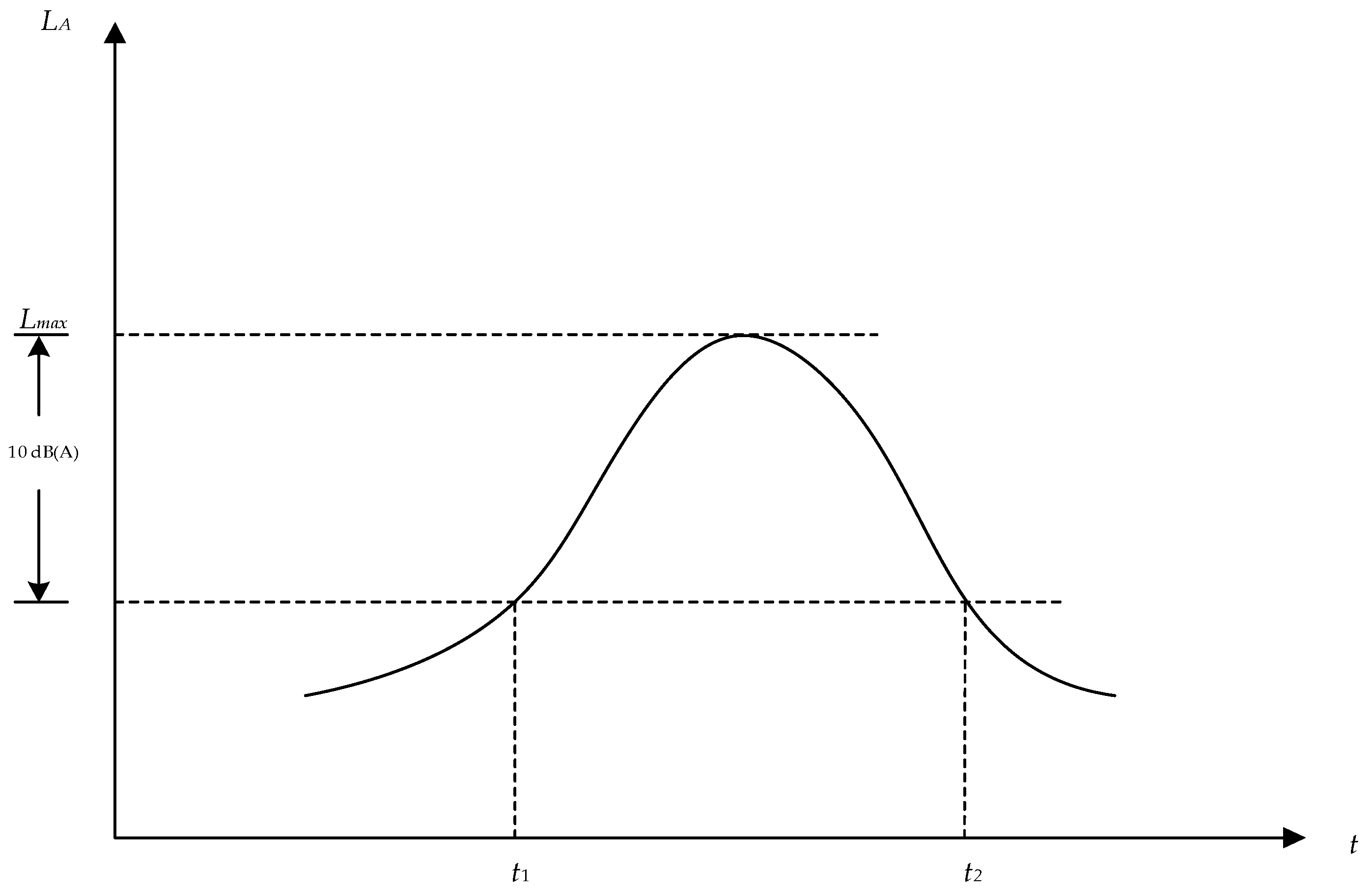

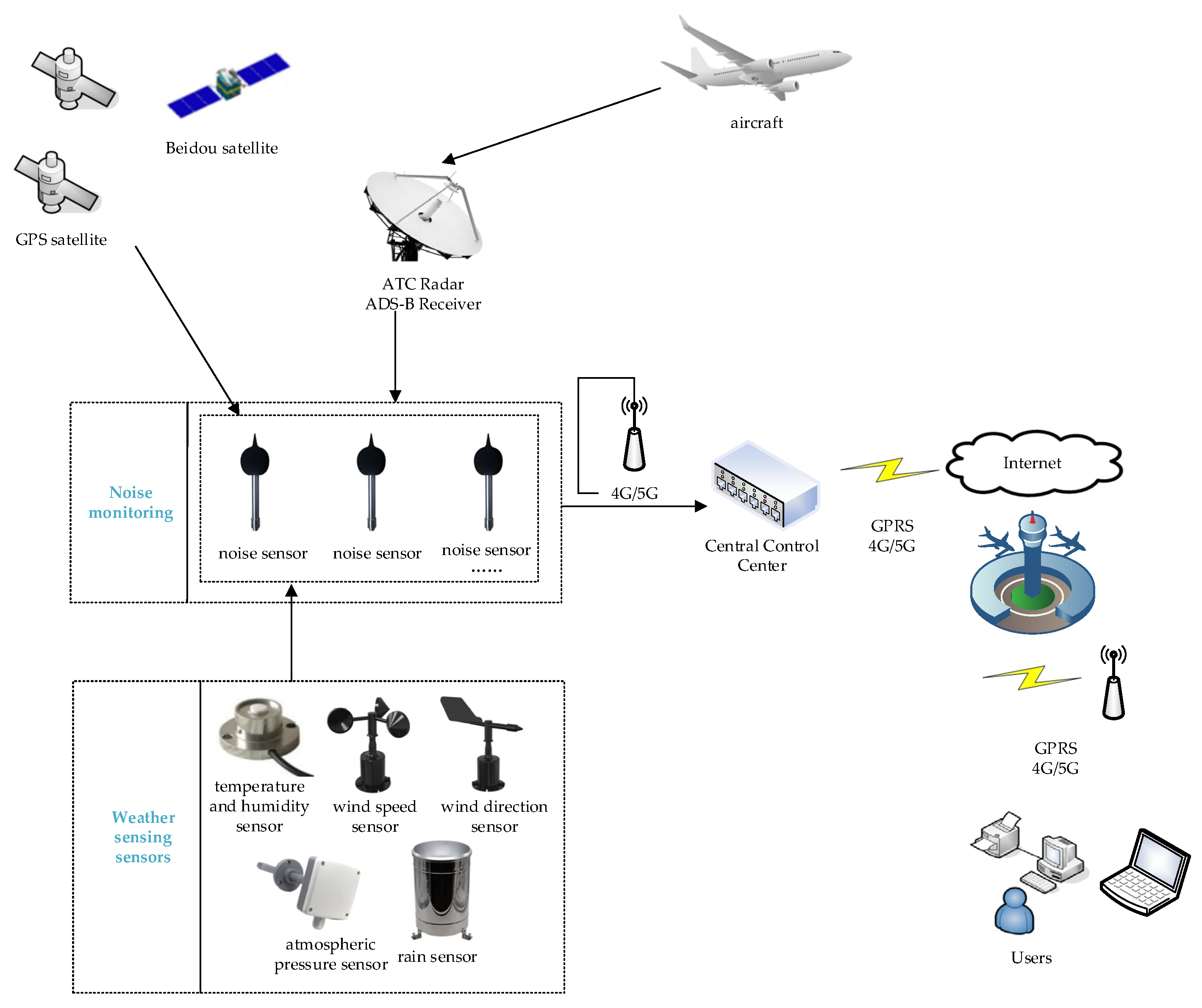
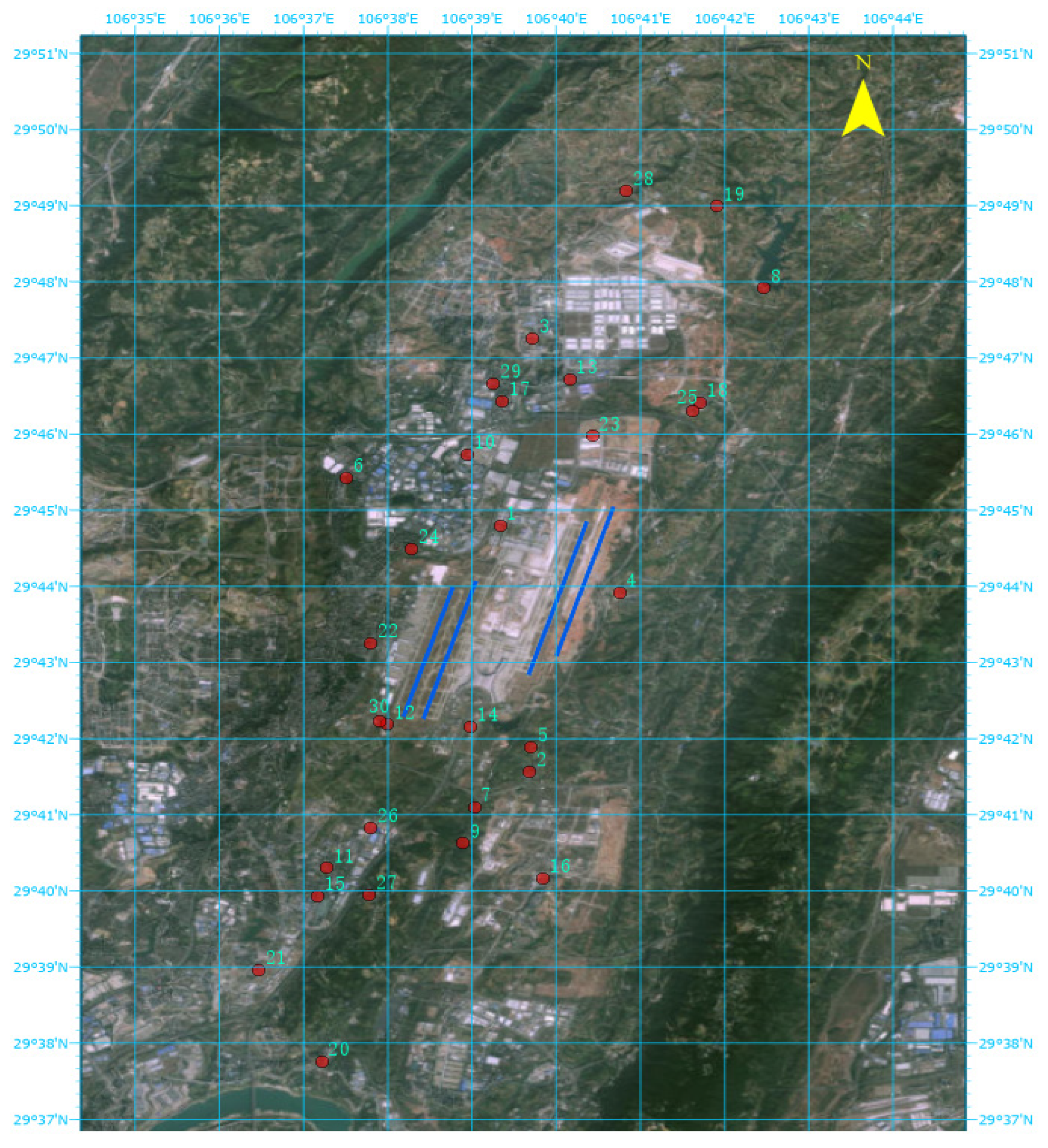
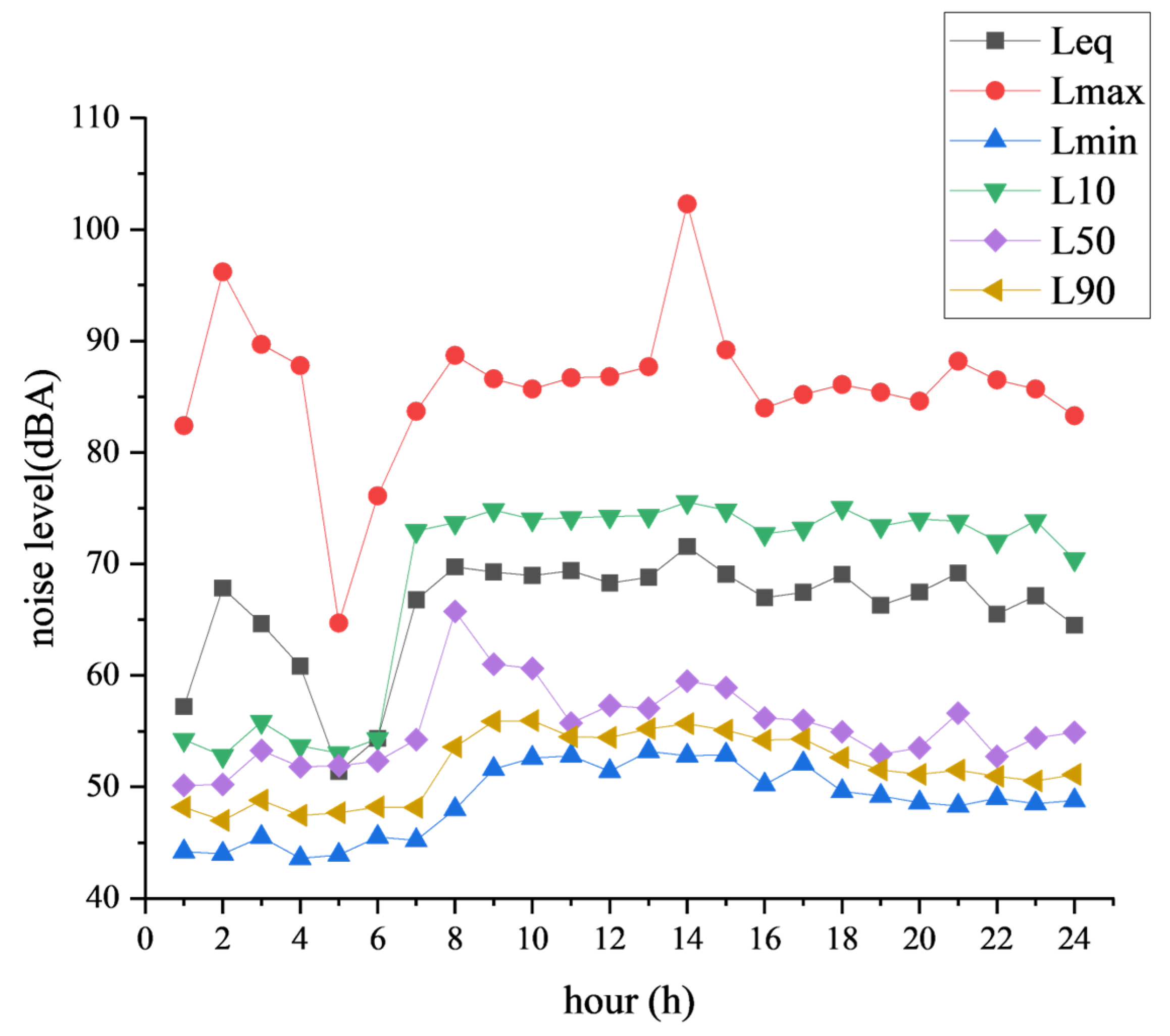
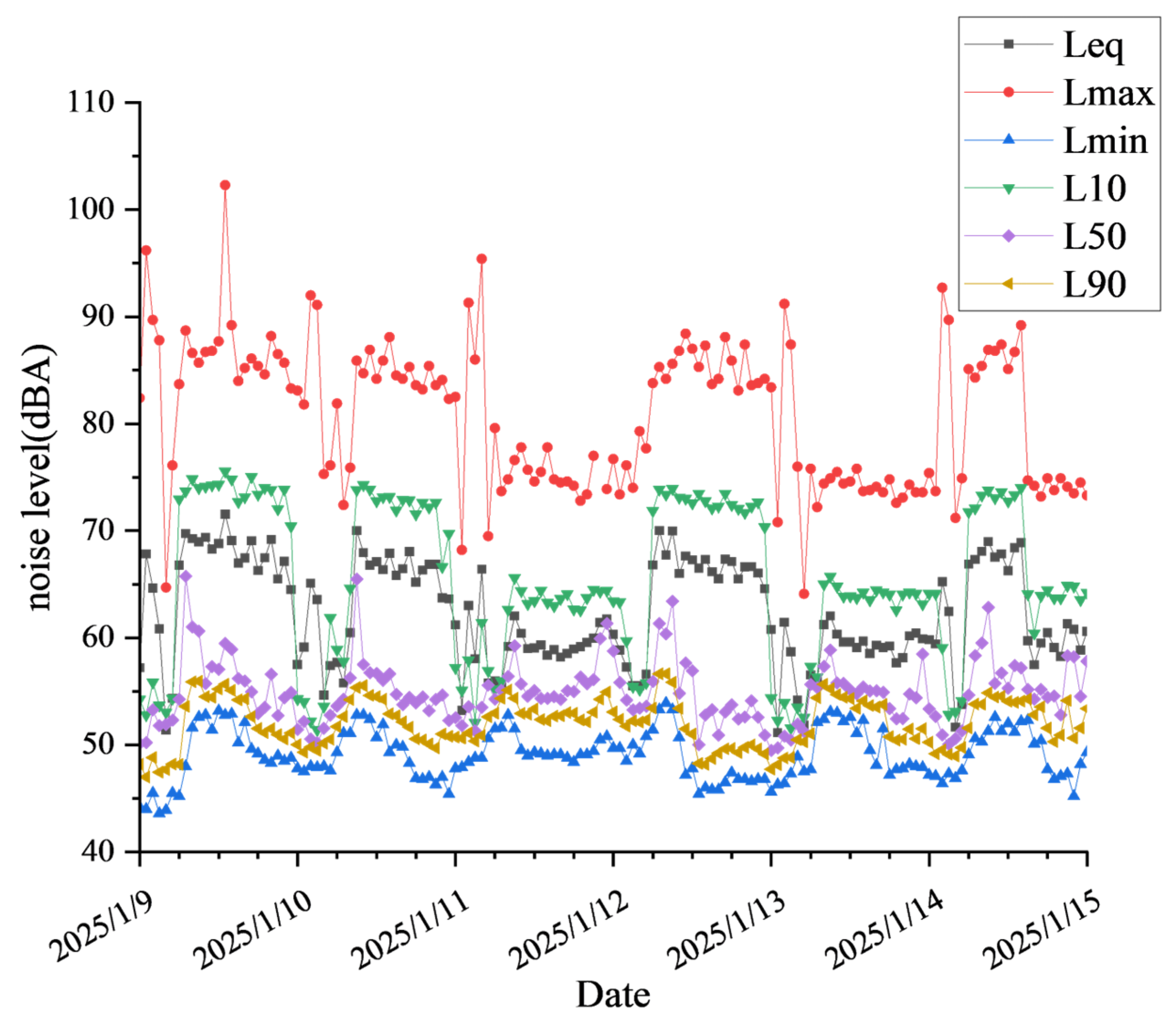
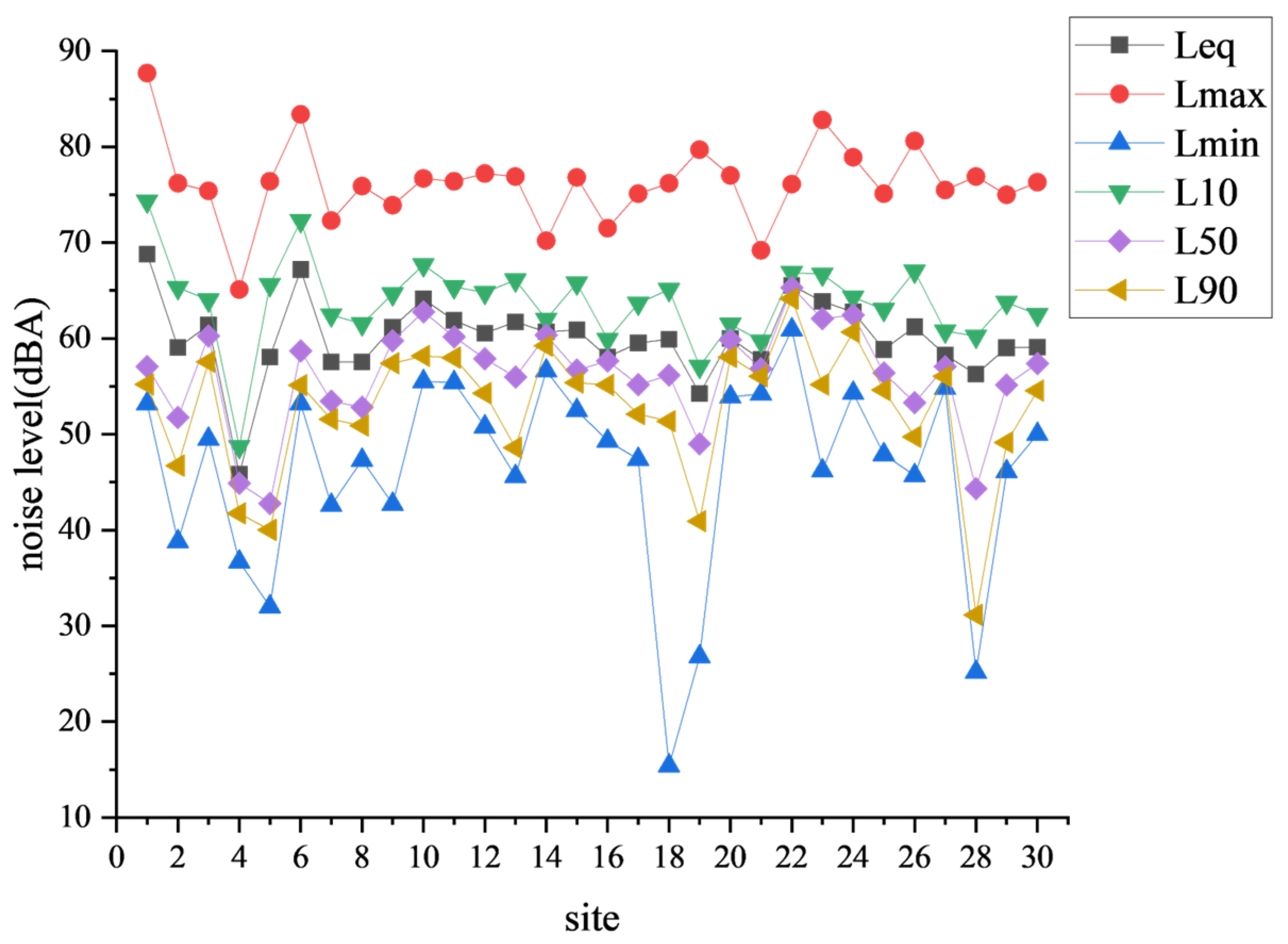

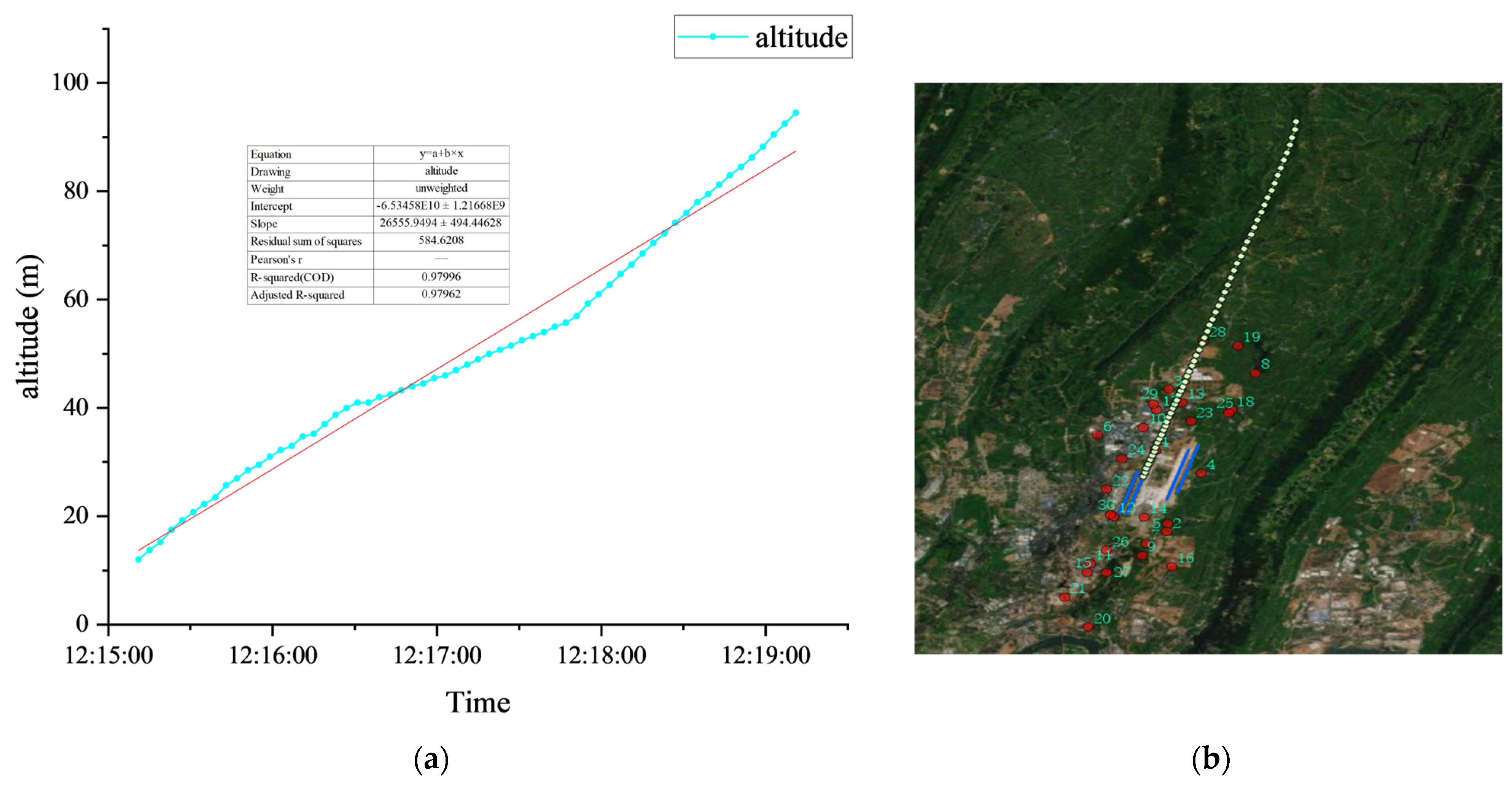
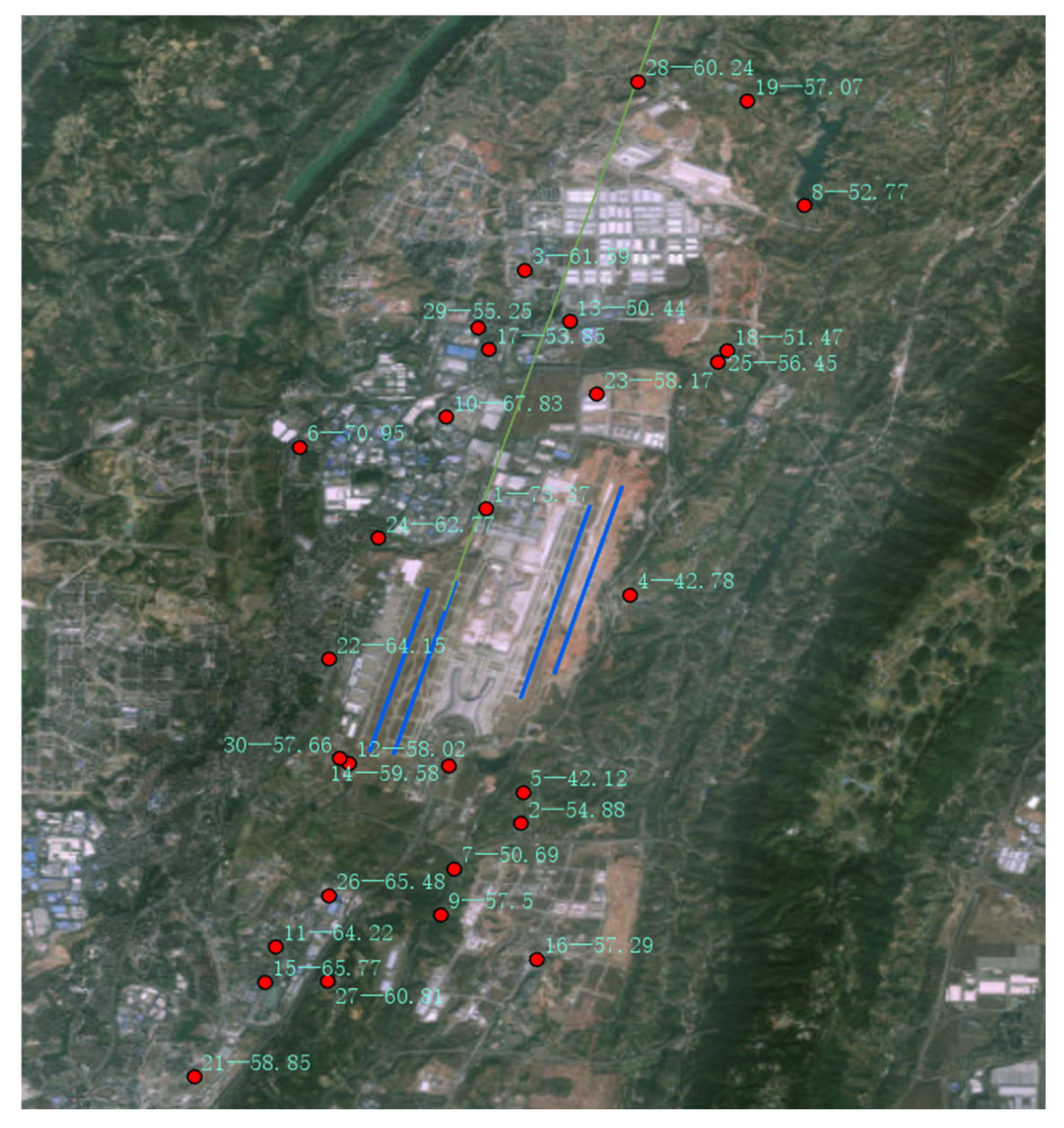


| Time (h) | Leq (dBA) | Lmax (dBA) | Lmin (dBA) | L10 (dBA) | L50 (dBA) | L90 (dBA) |
|---|---|---|---|---|---|---|
| 00:00:00 | 57.21895833 | 82.4 | 44.2 | 54.24346 | 50.136524 | 48.185143 |
| 01:00:00 | 67.82280027 | 96.2 | 44 | 52.802624 | 50.22635 | 47.000862 |
| 02:00:00 | 64.63856114 | 89.7 | 45.5 | 55.840534 | 53.27159 | 48.806835 |
| 03:00:00 | 60.8378527 | 87.8 | 43.6 | 53.680344 | 51.814022 | 47.4408 |
| 04:00:00 | 51.38262315 | 64.7 | 43.9 | 53.04144 | 51.911835 | 47.67696 |
| 05:00:00 | 54.37033719 | 76.1 | 45.5 | 54.31284 | 52.329857 | 48.197487 |
| 06:00:00 | 66.77060558 | 83.7 | 45.2 | 72.953186 | 54.26121 | 48.164143 |
| 07:00:00 | 69.73739269 | 88.7 | 48 | 73.70467 | 65.7477 | 53.58906 |
| 08:00:00 | 69.28191455 | 86.6 | 51.6 | 74.84679 | 61.018543 | 55.889618 |
| 09:00:00 | 68.9503474 | 85.7 | 52.6 | 74.0052 | 60.647236 | 55.952194 |
| 10:00:00 | 69.40169101 | 86.7 | 52.8 | 74.13598 | 55.73404 | 54.491386 |
| 11:00:00 | 68.28523386 | 86.8 | 51.4 | 74.267624 | 57.30418 | 54.43346 |
| 12:00:00 | 68.8080414 | 87.7 | 53.2 | 74.33332 | 57.060947 | 55.21252 |
| 13:00:00 | 71.56009479 | 102.3 | 52.8 | 75.558815 | 59.49364 | 55.667023 |
| 14:00:00 | 69.07133718 | 89.2 | 52.9 | 74.81701 | 58.9122 | 55.083817 |
| 15:00:00 | 66.97292174 | 84 | 50.2 | 72.708466 | 56.203506 | 54.206123 |
| 16:00:00 | 67.45932165 | 85.2 | 52.1 | 73.15712 | 55.963203 | 54.298683 |
| 17:00:00 | 69.05715316 | 86.1 | 49.6 | 75.04843 | 54.95877 | 52.631676 |
| 18:00:00 | 66.28781213 | 85.4 | 49.2 | 73.38589 | 52.93705 | 51.523018 |
| 19:00:00 | 67.47925763 | 84.6 | 48.6 | 74.03604 | 53.514595 | 51.131668 |
| 20:00:00 | 69.17686812 | 88.2 | 48.3 | 73.82557 | 56.62759 | 51.511982 |
| 21:00:00 | 65.50019676 | 86.5 | 49 | 72.037254 | 52.73172 | 50.955578 |
| 22:00:00 | 67.14169909 | 85.7 | 48.5 | 73.864075 | 54.404133 | 50.53803 |
| 23:00:00 | 64.50416703 | 83.3 | 48.8 | 70.41695 | 54.894753 | 51.10674 |
| Time (hh) | Wind Speed (m/s) | Wind Direction (°) | Temperature (°C) | Atmospheric Pressure (Pa) | Relative Humidity (%) | Precipitation (mm) |
|---|---|---|---|---|---|---|
| 00:00:00 | 0.001 | 7.003 | 7.342 | 984.522 | 84.635 | 14.576 |
| 01:00:00 | 0.025 | 7.001 | 7.264 | 985.808 | 85.826 | 14.592 |
| 02:00:00 | 0.118 | 7.002 | 6.967 | 985.515 | 88.246 | 14.662 |
| 03:00:00 | 0.037 | 7 | 6.755 | 985.488 | 90.286 | 15.116 |
| 04:00:00 | 0.033 | 7.003 | 6.725 | 985.682 | 90.068 | 15.183 |
| 05:00:00 | 0.083 | 7 | 6.728 | 986.06 | 89.068 | 15.191 |
| 06:00:00 | 0.036 | 7.001 | 6.678 | 986.798 | 90.258 | 15.187 |
| 07:00:00 | 0.066 | 7.003 | 6.6 | 986.342 | 91.036 | 15.161 |
| 08:00:00 | 0.026 | 7.003 | 6.797 | 986.994 | 90.486 | 15.153 |
| 09:00:00 | 0.036 | 7.001 | 7.247 | 987.763 | 87.978 | 15.174 |
| 10:00:00 | 0.163 | 7.001 | 7.727 | 989.76 | 84.281 | 15.187 |
| 11:00:00 | 0.34 | 7.001 | 8.001 | 988.483 | 82.359 | 15.165 |
| 12:00:00 | 0.209 | 7.003 | 7.769 | 987.731 | 81.266 | 15.156 |
| 13:00:00 | 0.202 | 7.001 | 6.96 | 987.765 | 89.064 | 15.172 |
| 14:00:00 | 0.099 | 7.003 | 6.961 | 987.856 | 89.28 | 15.261 |
| 15:00:00 | 0.114 | 7.004 | 7.019 | 986.643 | 89.513 | 15.283 |
| 16:00:00 | 0.07 | 7.001 | 7.259 | 987.737 | 87.758 | 15.283 |
| 17:00:00 | 0.183 | 7.002 | 7.376 | 987.473 | 86.439 | 15.261 |
| 18:00:00 | 0.151 | 7.001 | 7.301 | 989.534 | 86.049 | 15.296 |
| 19:00:00 | 0.167 | 7.005 | 7.396 | 988.968 | 84.353 | 15.278 |
| 20:00:00 | 0.184 | 7.003 | 7.48 | 990.685 | 83.198 | 15.27 |
| 21:00:00 | 0.091 | 7.003 | 7.526 | 991.287 | 82.269 | 15.287 |
| 22:00:00 | 0.187 | 7.002 | 7.396 | 991.712 | 83.434 | 15.278 |
| 23:00:00 | 0.396 | 7 | 6.988 | 991.204 | 87.049 | 15.278 |
| Site Number | Leq (dBA) | Lmax (dBA) | Lmin (dBA) | L10 (dBA) | L50 (dBA) | L90 (dBA) |
|---|---|---|---|---|---|---|
| 1 | 68.8080414 | 87.7 | 53.2 | 74.33332 | 57.060947 | 55.21252 |
| 2 | 59.06552721 | 76.2 | 38.8 | 65.3053 | 51.742054 | 46.71864 |
| 3 | 61.38223383 | 75.4 | 49.5 | 64.02256 | 60.247715 | 57.564903 |
| 4 | 45.85823244 | 65.1 | 36.7 | 48.717724 | 44.883797 | 41.740036 |
| 5 | 58.05757312 | 76.4 | 32 | 65.614296 | 42.77845 | 40.01837 |
| 6 | 67.18098721 | 83.4 | 53.2 | 72.28866 | 58.72051 | 55.11236 |
| 7 | 57.53974885 | 72.3 | 42.6 | 62.449257 | 53.430676 | 51.55485 |
| 8 | 57.53863789 | 75.9 | 47.3 | 61.515705 | 52.830418 | 50.91665 |
| 9 | 61.16363204 | 73.9 | 42.7 | 64.64619 | 59.766407 | 57.403732 |
| 10 | 64.09911025 | 76.7 | 55.5 | 67.68079 | 62.800972 | 58.178623 |
| 11 | 61.87966775 | 76.4 | 55.4 | 65.371315 | 60.16599 | 57.991085 |
| 12 | 60.54930981 | 77.2 | 50.8 | 64.80918 | 57.86744 | 54.276775 |
| 13 | 61.7346707 | 76.9 | 45.6 | 66.09535 | 55.975376 | 48.603966 |
| 14 | 60.67857799 | 70.2 | 56.6 | 62.006264 | 60.34982 | 59.245968 |
| 15 | 60.88050682 | 76.8 | 52.5 | 65.769424 | 56.69144 | 55.37898 |
| 16 | 58.06431252 | 71.5 | 49.3 | 59.89837 | 57.643604 | 55.127884 |
| 17 | 59.54150133 | 75.1 | 47.4 | 63.675392 | 55.168346 | 52.11068 |
| 18 | 59.90850949 | 76.2 | 15.4 | 65.106865 | 56.15736 | 51.361378 |
| 19 | 54.22695959 | 79.7 | 26.8 | 57.09515 | 49.00404 | 40.911175 |
| 20 | 59.99734105 | 77 | 53.9 | 61.487232 | 59.84029 | 58.0622 |
| 21 | 57.81065247 | 69.2 | 54.2 | 59.731377 | 56.828323 | 56.047817 |
| 22 | 65.53735521 | 76.1 | 60.9 | 66.87146 | 65.30715 | 64.152336 |
| 23 | 63.86458017 | 82.8 | 46.2 | 66.70404 | 62.073383 | 55.175987 |
| 24 | 62.76494539 | 78.9 | 54.3 | 64.296875 | 62.417725 | 60.666344 |
| 25 | 58.84833311 | 75.1 | 47.9 | 63.01381 | 56.4168 | 54.608795 |
| 26 | 61.21560683 | 80.6 | 45.7 | 67.029175 | 53.304443 | 49.730385 |
| 27 | 58.282585 | 75.5 | 54.8 | 60.78647 | 57.0738 | 56.04345 |
| 28 | 56.25931136 | 76.9 | 25.2 | 60.242733 | 44.313698 | 31.132519 |
| 29 | 59.02602687 | 75 | 46.1 | 63.767994 | 55.144184 | 49.134953 |
| 30 | 59.10325463 | 76.3 | 50 | 62.489525 | 57.380215 | 54.55352 |
| No. | Incident Type | Start Time (hh:mm:ss) | Peak Time (hh:mm:ss) | Duration (s) | Leq (dBA) | SEL (dBA) | Lmax (dBA) | Connecting Flights |
|---|---|---|---|---|---|---|---|---|
| 1 | Aviation incident | 12:06:05 | 12:06:25 | 45 | 75.36 | 86.50 | 83.60 | 9C6196 |
| 2 | Aviation incident | 12:07:40 | 12:08:05 | 50 | 76.62 | 88.08 | 85.10 | MU2926 |
| 3 | Aviation incident | 12:09:27 | 12:09:47 | 41 | 72.07 | 83.83 | 79.20 | CZ3466, MF8472 |
| 4 | Aviation incident | 12:13:25 | 12:13:47 | 46 | 75.15 | 86.91 | 83.30 | DZ6285 |
| 5 | Aviation incident | 12:15:14 | 12:15:36 | 49 | 74.37 | 86.41 | 82.00 | 3U3209 |
| 6 | Aviation incident | 12:18:05 | 12:18:24 | 46 | 76.02 | 86.81 | 84.40 | CA1432 |
| 7 | Aviation incident | 12:20:10 | 12:20:25 | 41 | 72.28 | 82.69 | 80.70 | 8L9606 |
| 8 | Non-aviation incident | 12:21:37 | 12:21:55 | 46 | 75.55 | 85.55 | 84.10 | -- |
| 9 | Aviation incident | 12:23:13 | 12:23:30 | 45 | 74.00 | 85.46 | 81.30 | PN6317 |
| 10 | Non-aviation incident | 12:28:14 | 12:28:34 | 44 | 75.48 | 86.94 | 82.70 | -- |
| Site Number | Data_Time (hh:mm:ss) | Noise_Value (dBA) | Label |
|---|---|---|---|
| 1 | 2025-01-09 12:15 | 73.37 | 1—73.37 |
| 2 | 2025-01-09 12:15 | 54.88 | 2—54.88 |
| 3 | 2025-01-09 12:15 | 61.59 | 3—61.59 |
| 4 | 2025-01-09 12:15 | 42.78 | 4—42.78 |
| 5 | 2025-01-09 12:15 | 42.12 | 5—42.12 |
| 6 | 2025-01-09 12:15 | 70.95 | 6—70.95 |
| 7 | 2025-01-09 12:15 | 50.69 | 7—50.69 |
| 8 | 2025-01-09 12:15 | 52.77 | 8—52.77 |
| 9 | 2025-01-09 12:15 | 57.5 | 9—57.5 |
| 10 | 2025-01-09 12:15 | 67.83 | 10—67.83 |
| 11 | 2025-01-09 12:15 | 64.22 | 11—64.22 |
| 12 | 2025-01-09 12:15 | 58.02 | 12—58.02 |
| 13 | 2025-01-09 12:15 | 50.44 | 13—50.44 |
| 14 | 2025-01-09 12:15 | 59.58 | 14—59.58 |
| 15 | 2025-01-09 12:15 | 65.77 | 15—65.77 |
| 16 | 2025-01-09 12:15 | 57.29 | 16—57.29 |
| 17 | 2025-01-09 12:15 | 53.85 | 17—53.85 |
| 18 | 2025-01-09 12:15 | 51.47 | 18—51.47 |
| 19 | 2025-01-09 12:15 | 57.07 | 19—57.07 |
| 20 | 2025-01-09 12:15 | 60.25 | 20—60.25 |
| 21 | 2025-01-09 12:15 | 58.85 | 21—58.85 |
| 22 | 2025-01-09 12:15 | 64.15 | 22—64.15 |
| 23 | 2025-01-09 12:15 | 58.17 | 23—58.17 |
| 24 | 2025-01-09 12:15 | 62.77 | 24—62.77 |
| 25 | 2025-01-09 12:15 | 56.45 | 25—56.45 |
| 26 | 2025-01-09 12:15 | 65.48 | 26—65.48 |
| 27 | 2025-01-09 12:15 | 60.81 | 27—60.81 |
| 28 | 2025-01-09 12:15 | 60.24 | 28—60.24 |
| 29 | 2025-01-09 12:15 | 55.25 | 29—55.25 |
| 30 | 2025-01-09 12:15 | 57.66 | 30—57.66 |
Disclaimer/Publisher’s Note: The statements, opinions and data contained in all publications are solely those of the individual author(s) and contributor(s) and not of MDPI and/or the editor(s). MDPI and/or the editor(s) disclaim responsibility for any injury to people or property resulting from any ideas, methods, instructions or products referred to in the content. |
© 2025 by the authors. Licensee MDPI, Basel, Switzerland. This article is an open access article distributed under the terms and conditions of the Creative Commons Attribution (CC BY) license (https://creativecommons.org/licenses/by/4.0/).
Share and Cite
Liu, J.; Sun, S.; Tang, K.; Fan, X.; Lv, J.; Fu, Y.; Feng, X.; Zeng, L. IoT-Based Airport Noise Perception and Monitoring: Multi-Source Data Fusion, Spatial Distribution Modeling, and Analysis. Sensors 2025, 25, 2347. https://doi.org/10.3390/s25082347
Liu J, Sun S, Tang K, Fan X, Lv J, Fu Y, Feng X, Zeng L. IoT-Based Airport Noise Perception and Monitoring: Multi-Source Data Fusion, Spatial Distribution Modeling, and Analysis. Sensors. 2025; 25(8):2347. https://doi.org/10.3390/s25082347
Chicago/Turabian StyleLiu, Jie, Shiman Sun, Ke Tang, Xinyu Fan, Jihong Lv, Yinxiang Fu, Xinpu Feng, and Liang Zeng. 2025. "IoT-Based Airport Noise Perception and Monitoring: Multi-Source Data Fusion, Spatial Distribution Modeling, and Analysis" Sensors 25, no. 8: 2347. https://doi.org/10.3390/s25082347
APA StyleLiu, J., Sun, S., Tang, K., Fan, X., Lv, J., Fu, Y., Feng, X., & Zeng, L. (2025). IoT-Based Airport Noise Perception and Monitoring: Multi-Source Data Fusion, Spatial Distribution Modeling, and Analysis. Sensors, 25(8), 2347. https://doi.org/10.3390/s25082347






